NCERT Solutions for Class 6 Maths Chapter 11 – Algebra comprises of the 5 Exercises
This Chapter contains the Exercises relating to the following topics, which are discussed in Chapter 11 – Algebra Class 6 NCERT book : –
- 11.1 Introduction
- 11.2 Matchstick Patterns
- 11.3 The Idea of a Variable
- 11.4 More Matchstick Patterns
- 11.5 More Examples of Variables
- 11.6 Use of Variables in Common Rules
- 11.7 Expressions with Variables
- 11.8 Using Expressions Practically
- 11.9 What is an Equation?
- 11.10 Solution of an Equation
NCERT Solutions for Class 6 Maths Chapter 11 Exercise 11.1

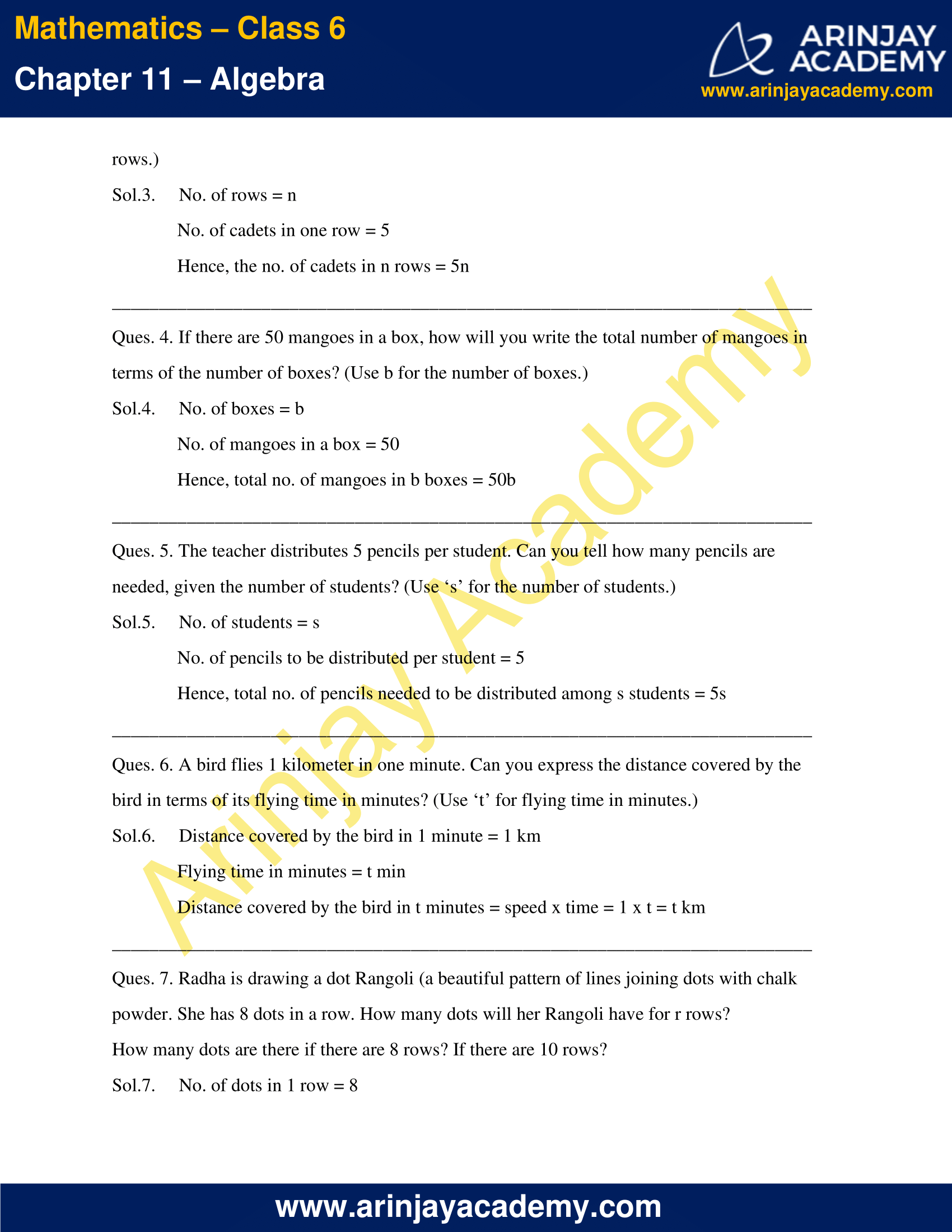
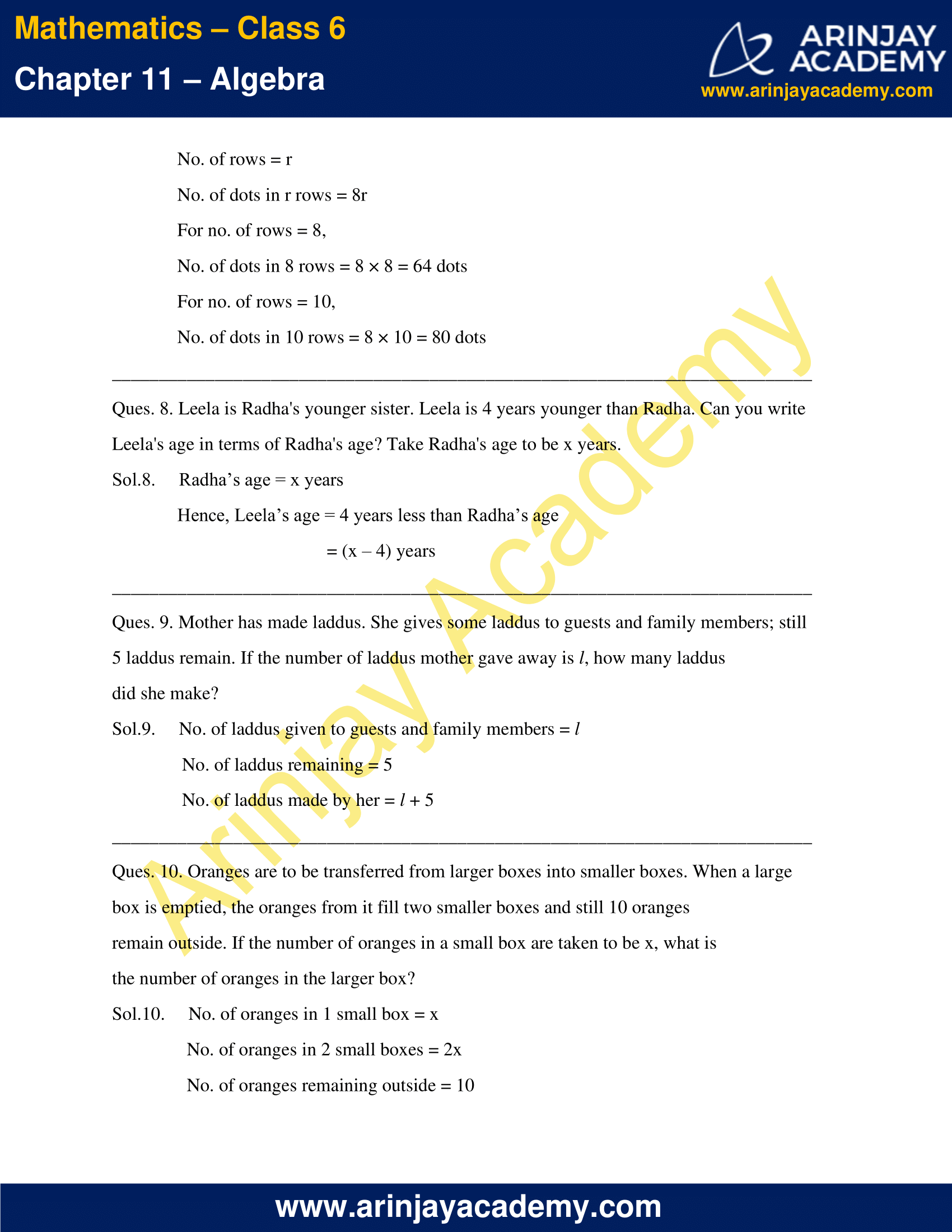
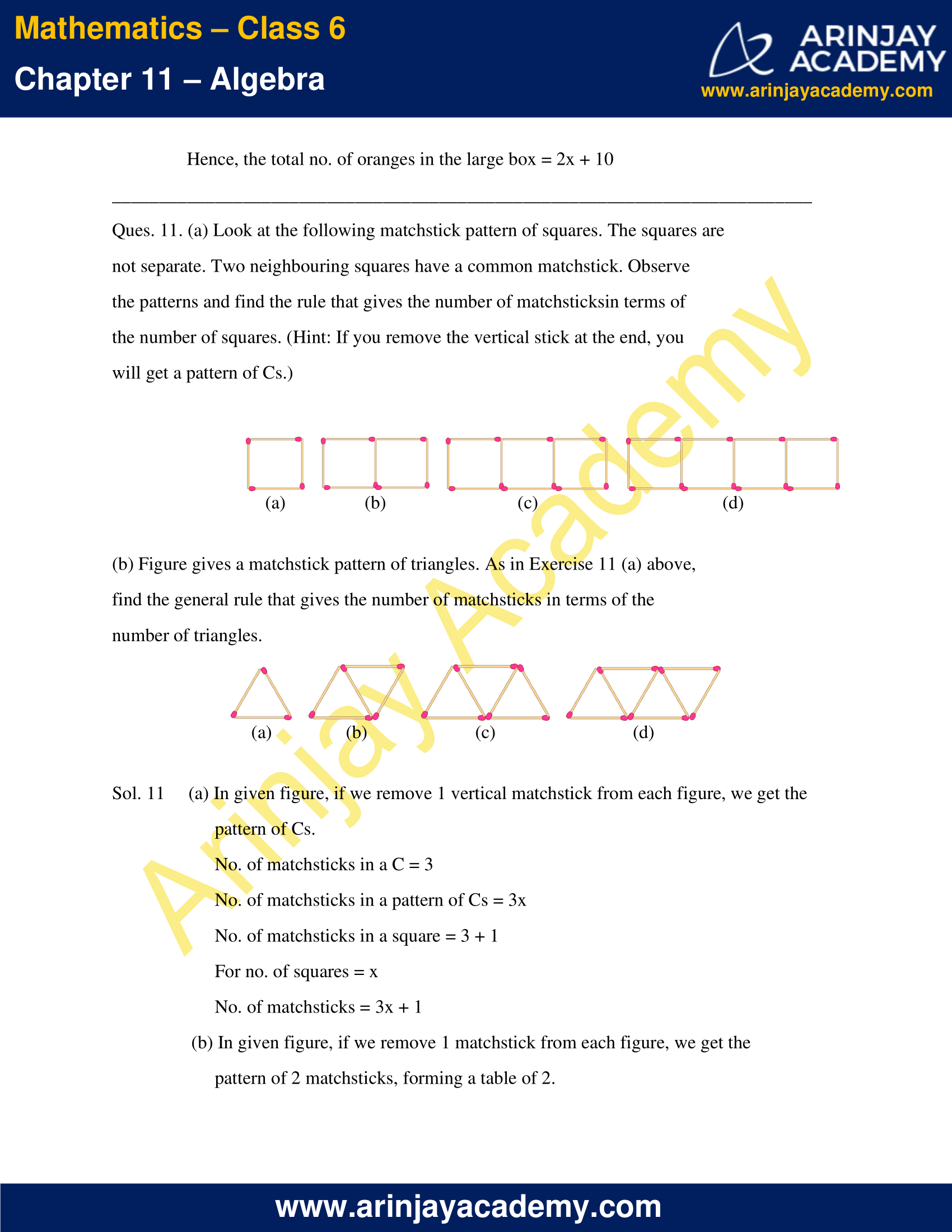
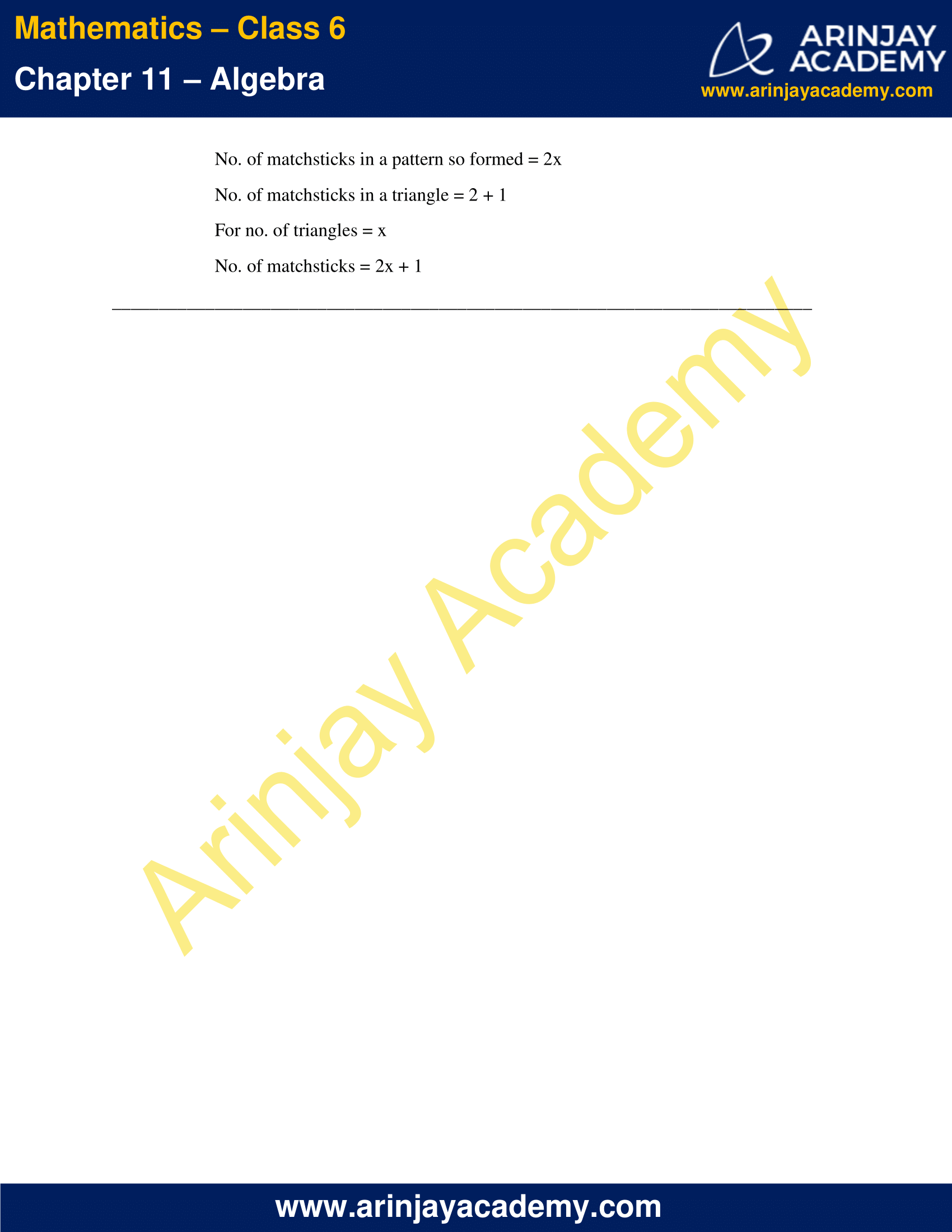
NCERT Solutions for Class 6 Maths Chapter 11 Exercise 11.2
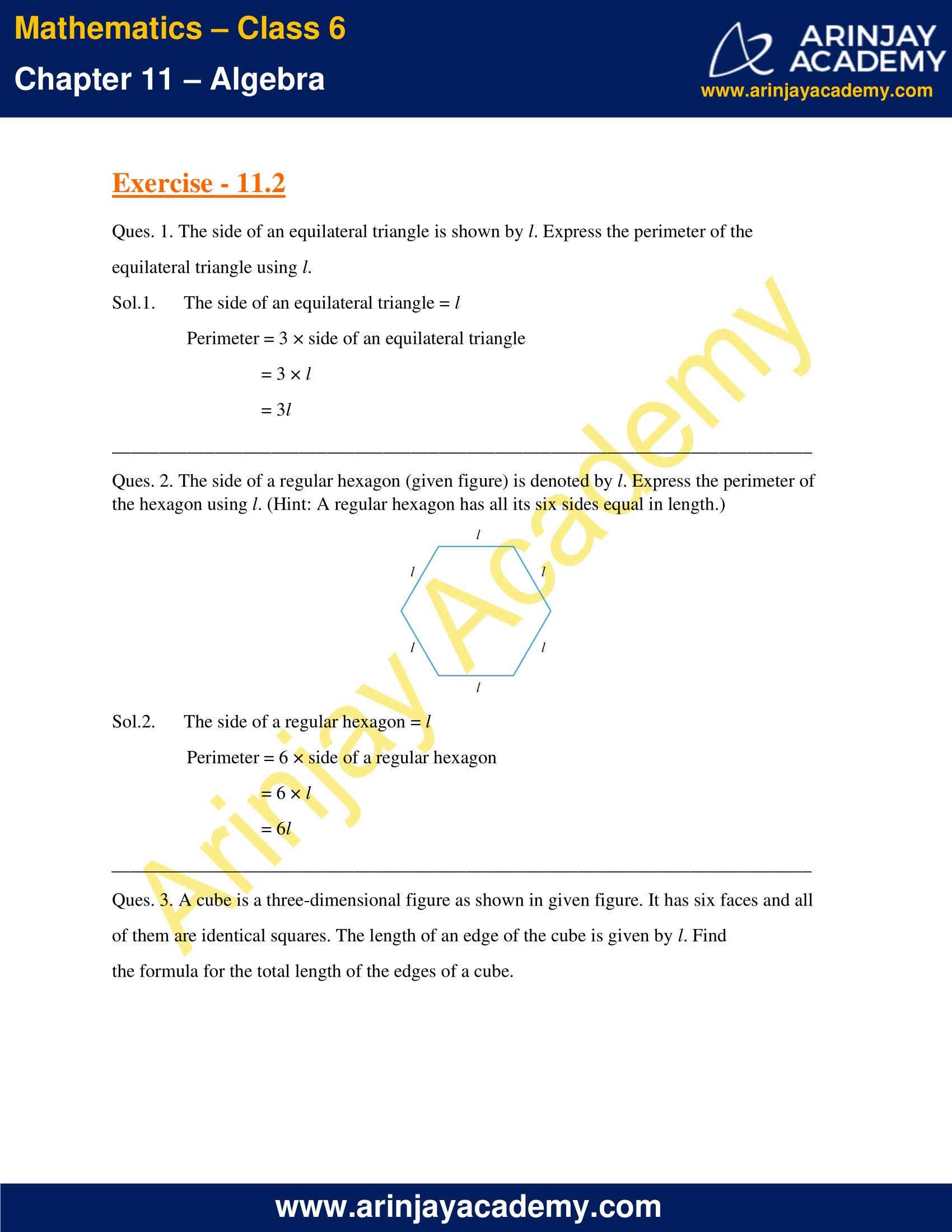
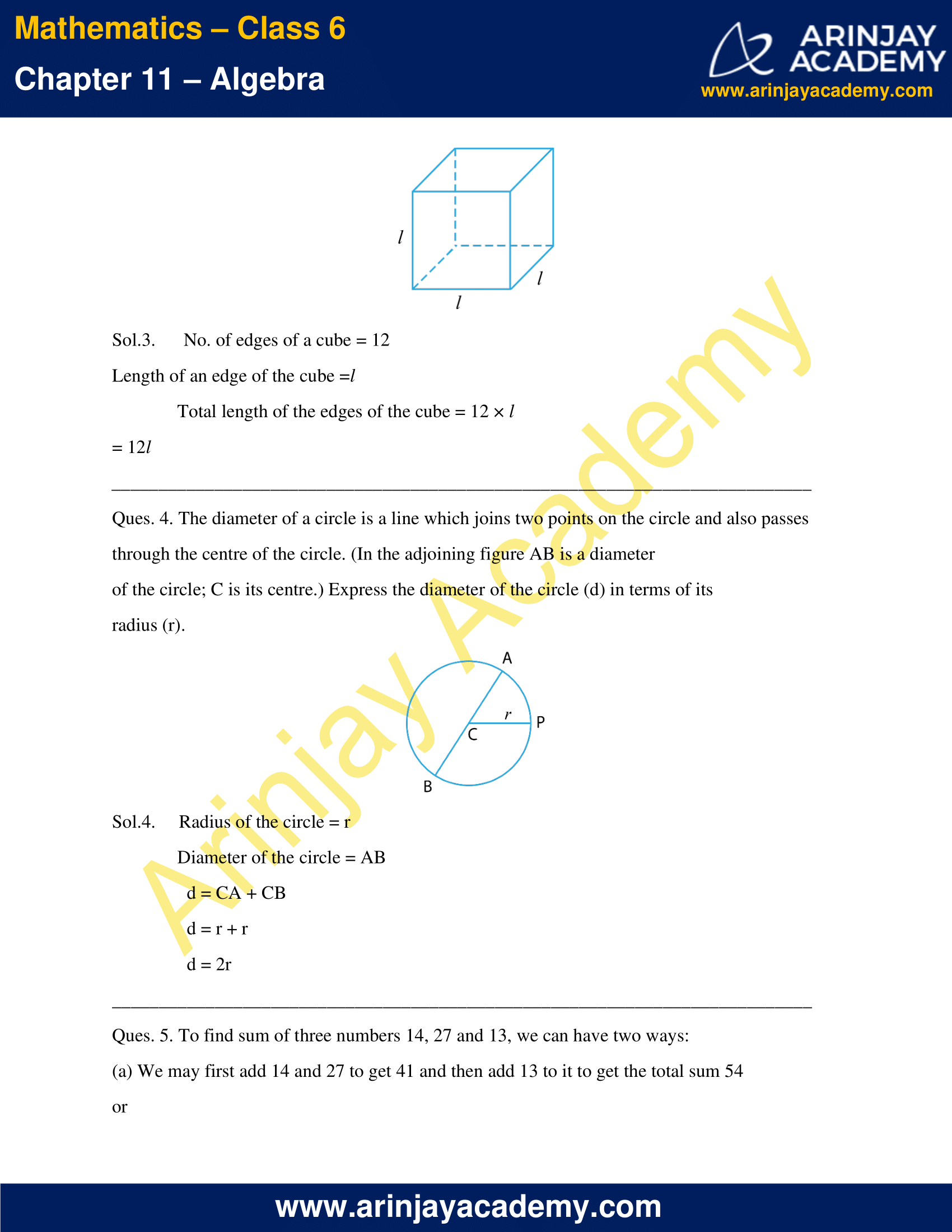
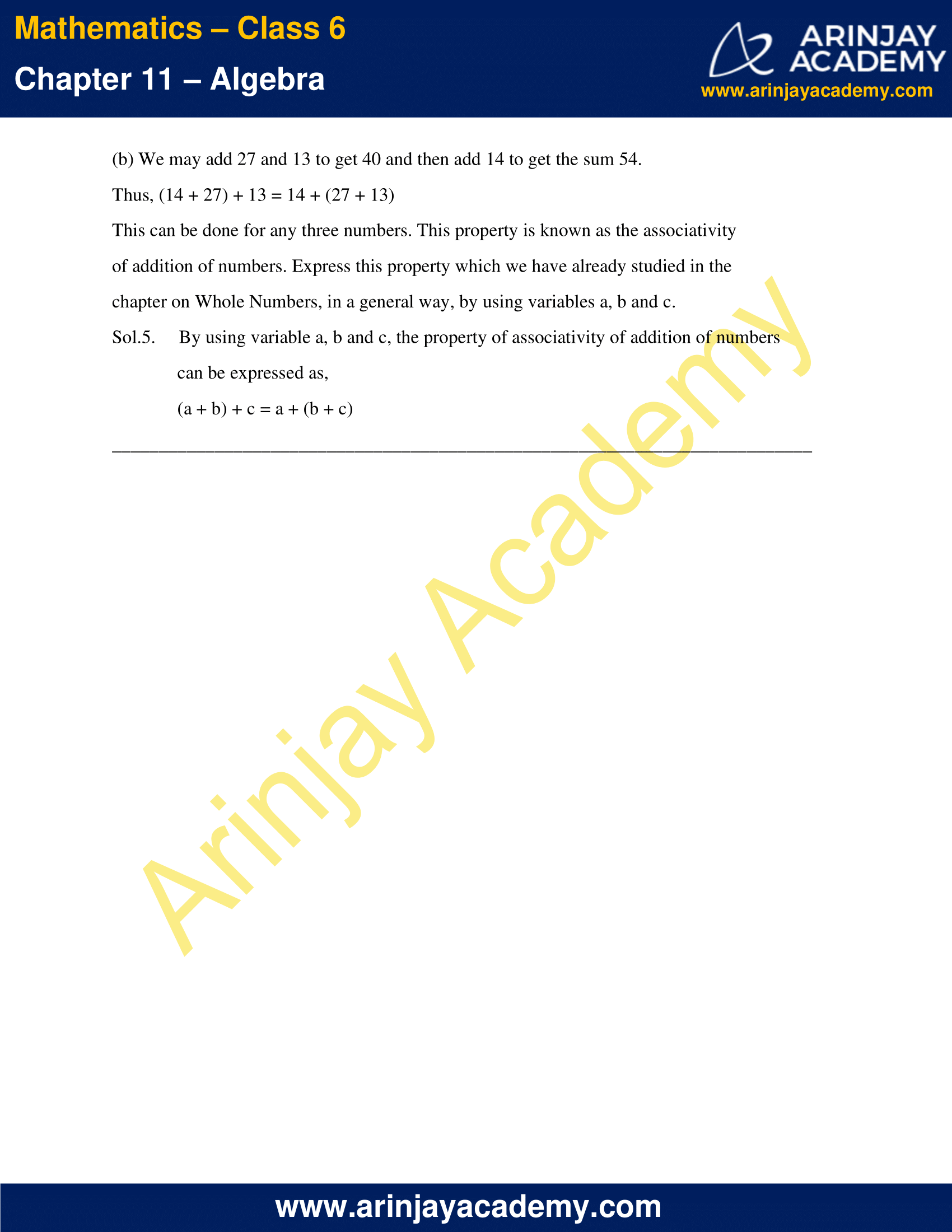
NCERT Solutions for Class 6 Maths Chapter 11 Exercise 11.3

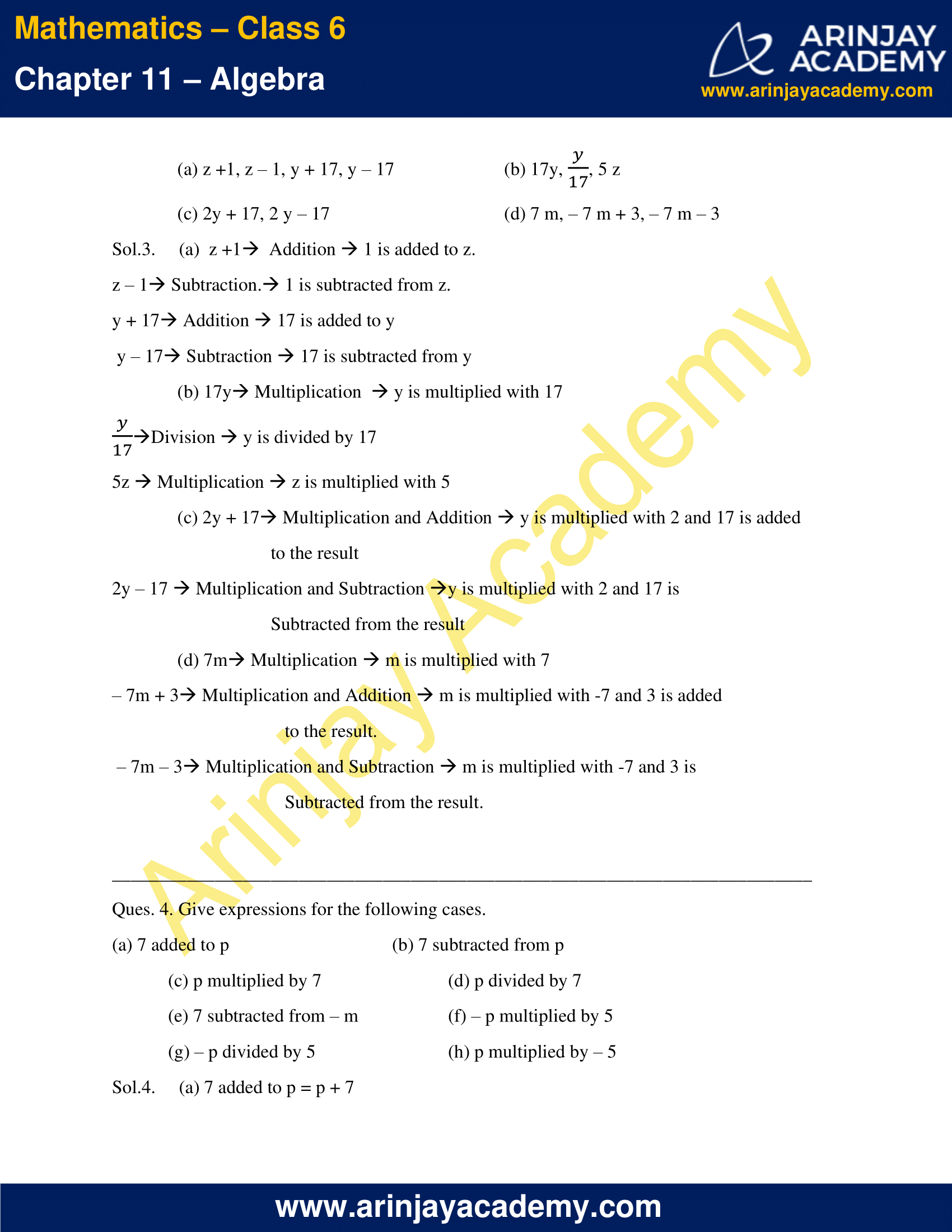
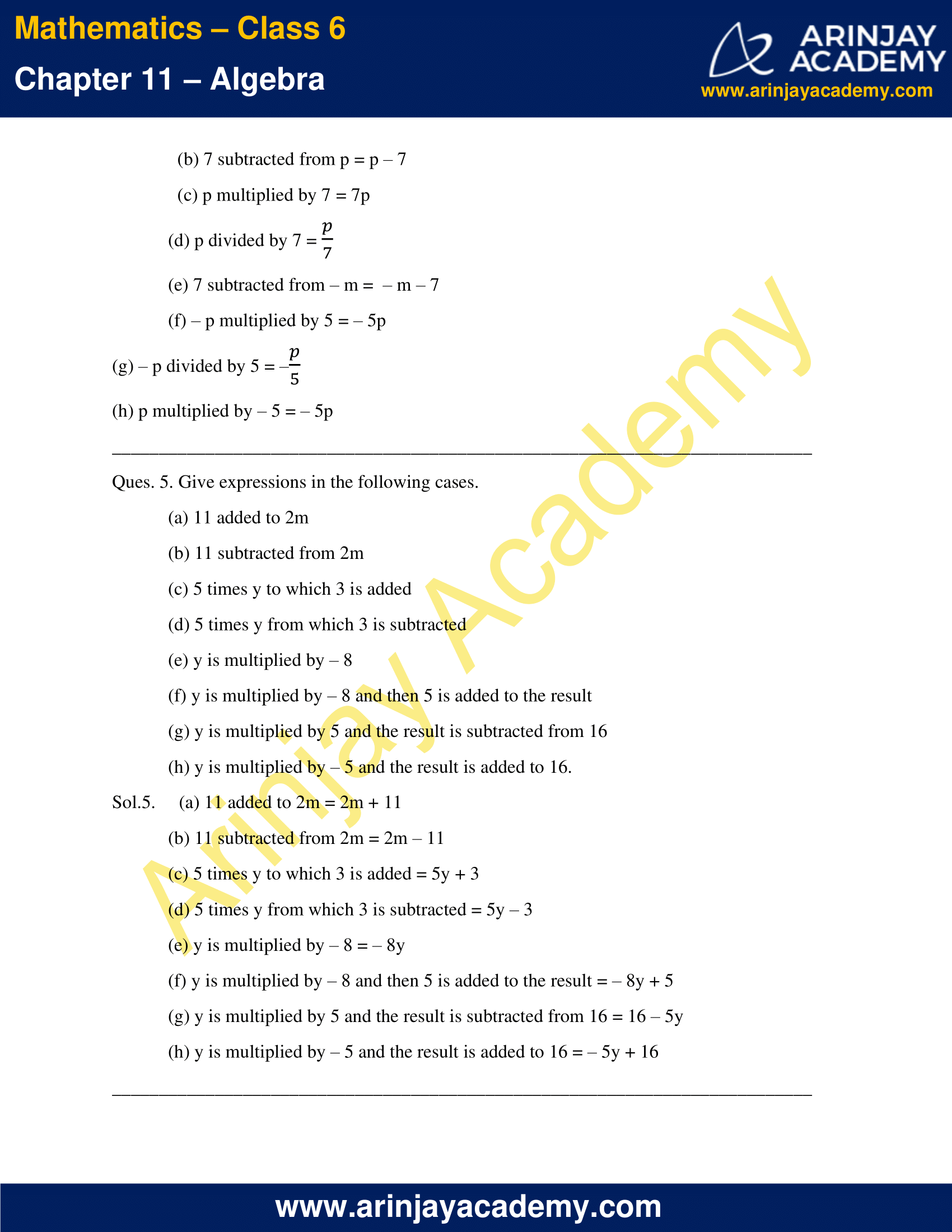
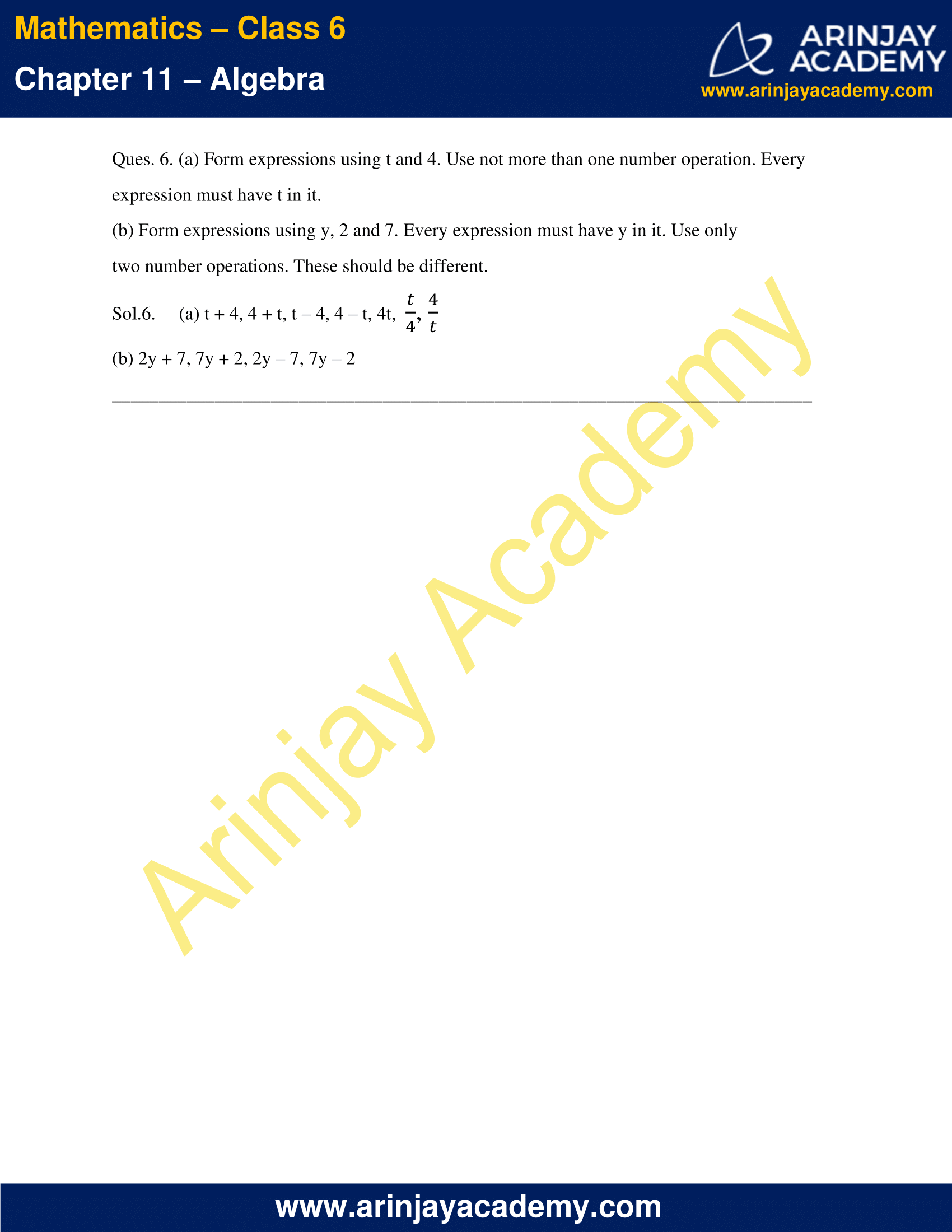
NCERT Solutions for Class 6 Maths Chapter 11 Exercise 11.4
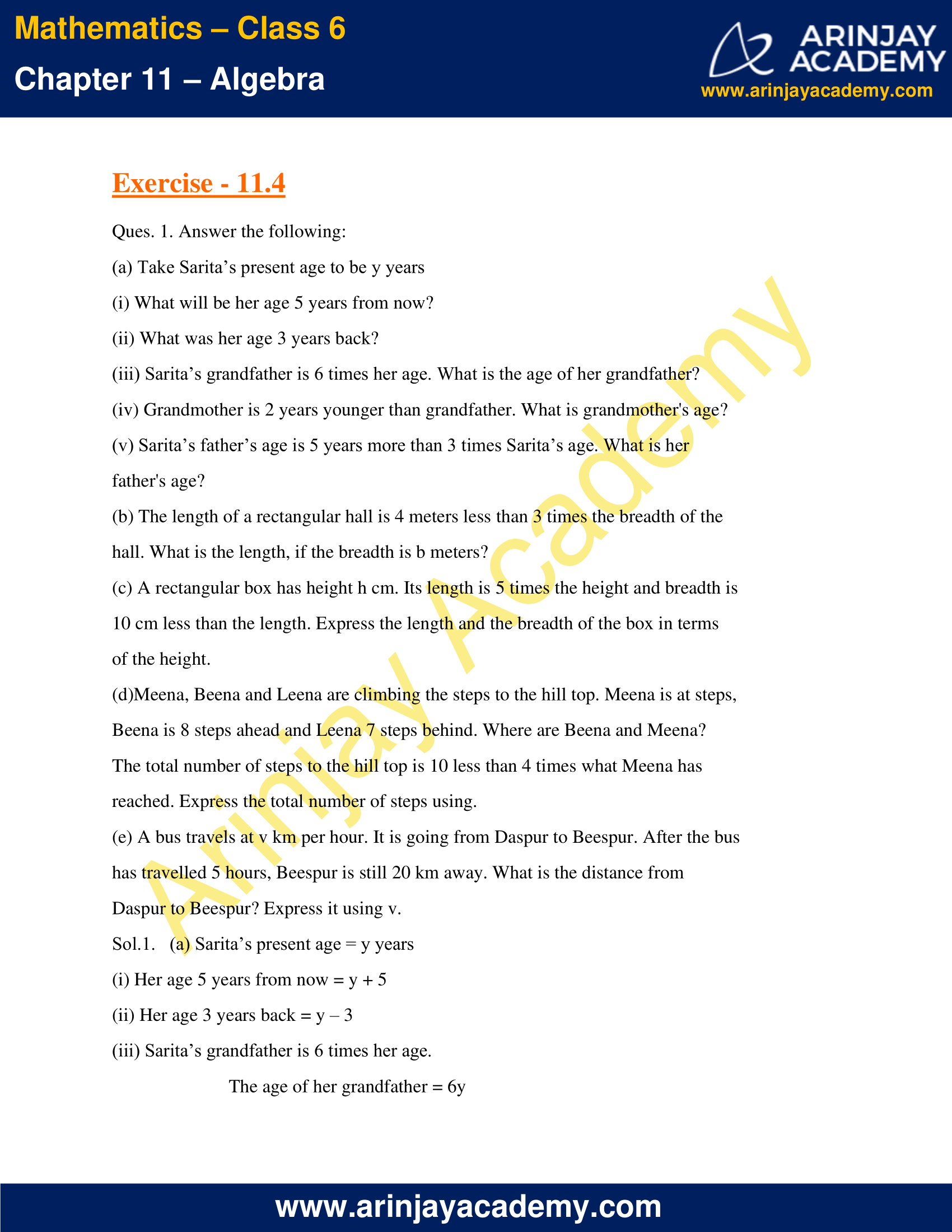
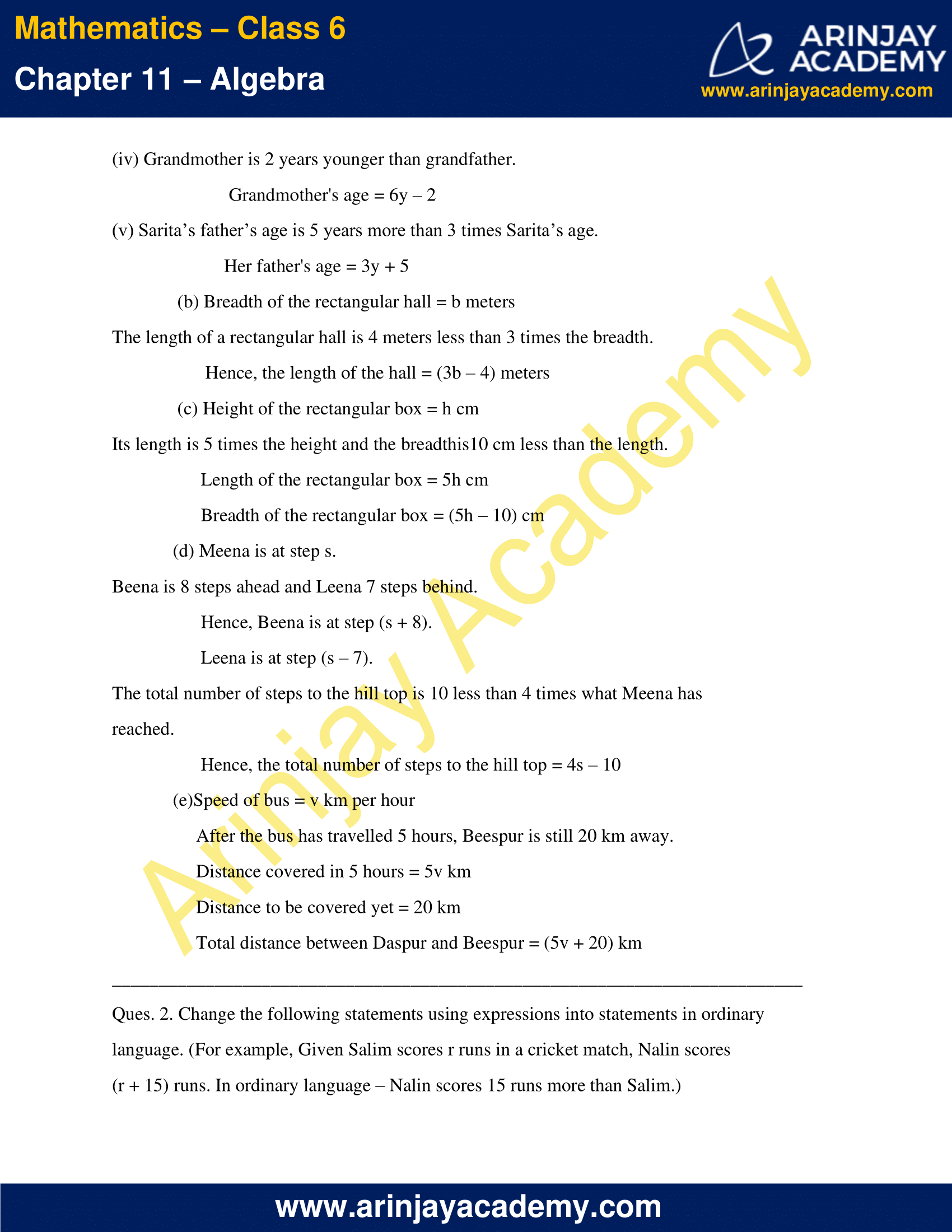
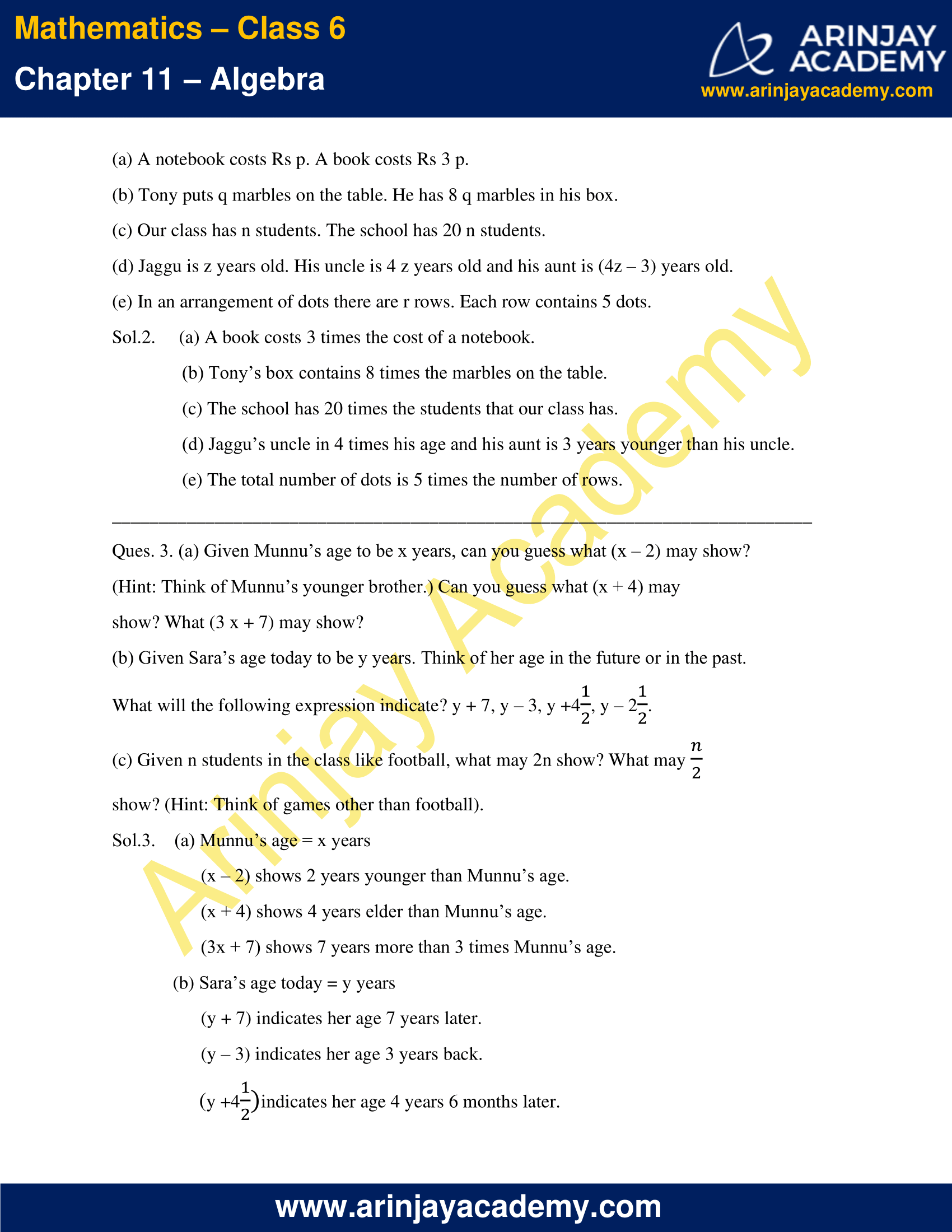
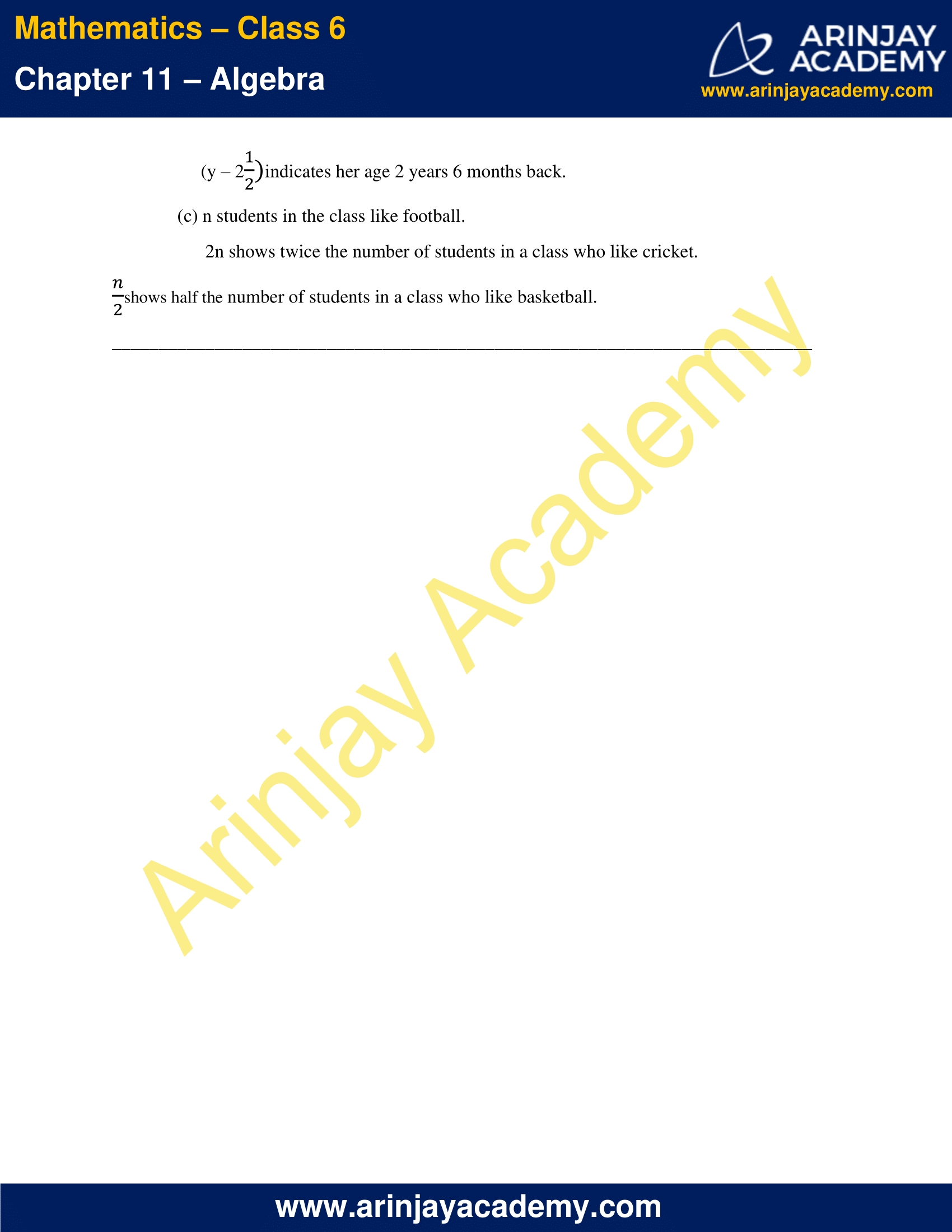
NCERT Solutions for Class 6 Maths Chapter 11 Exercise 11.5
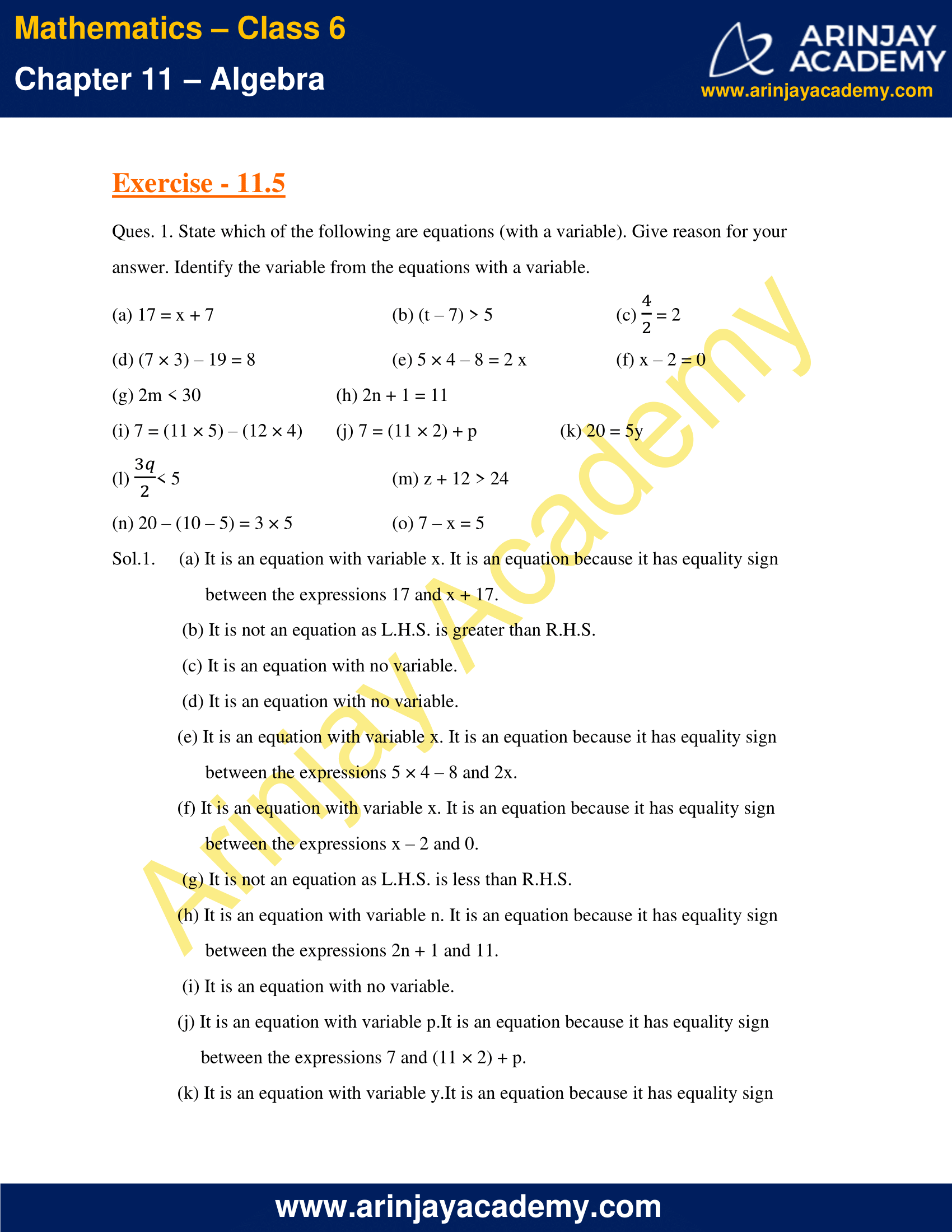
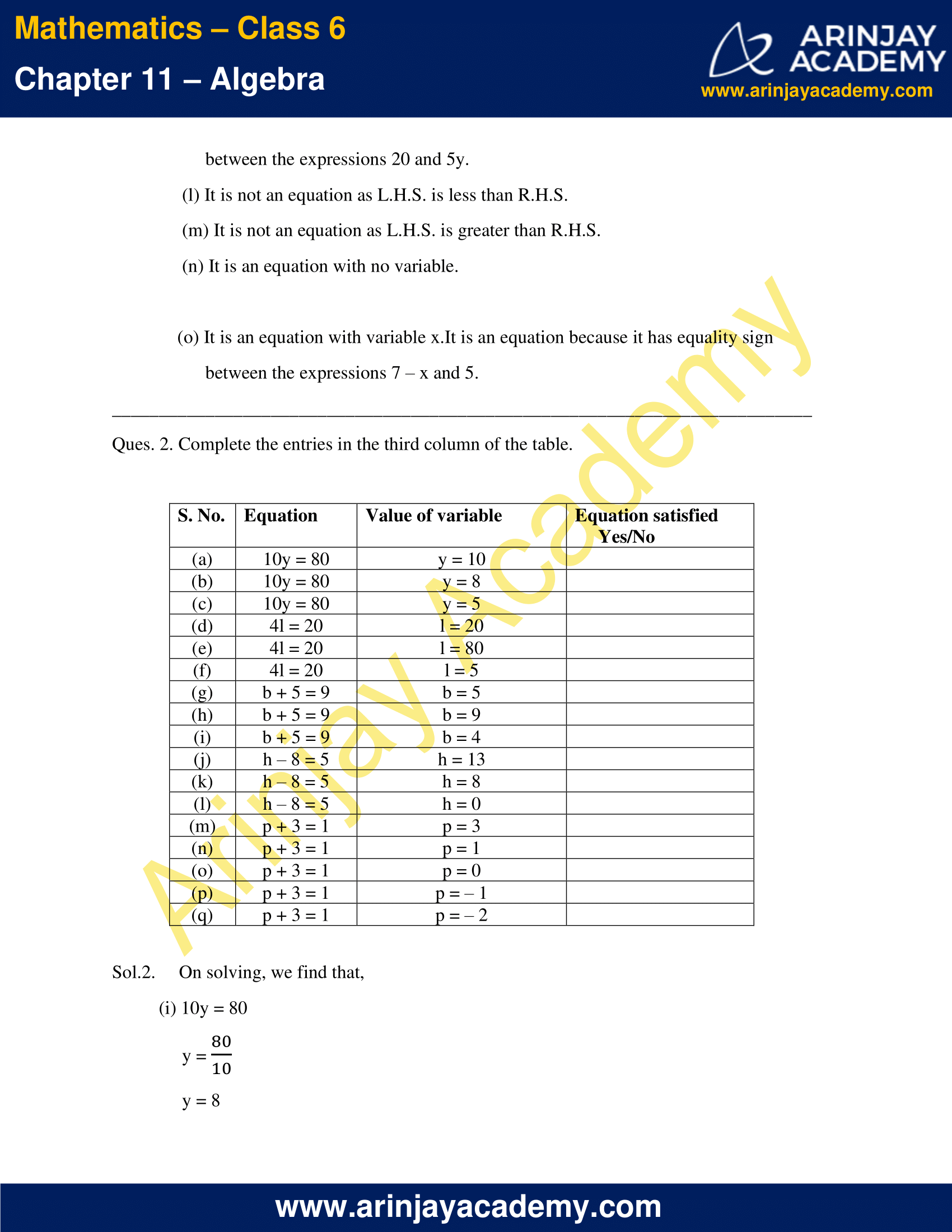
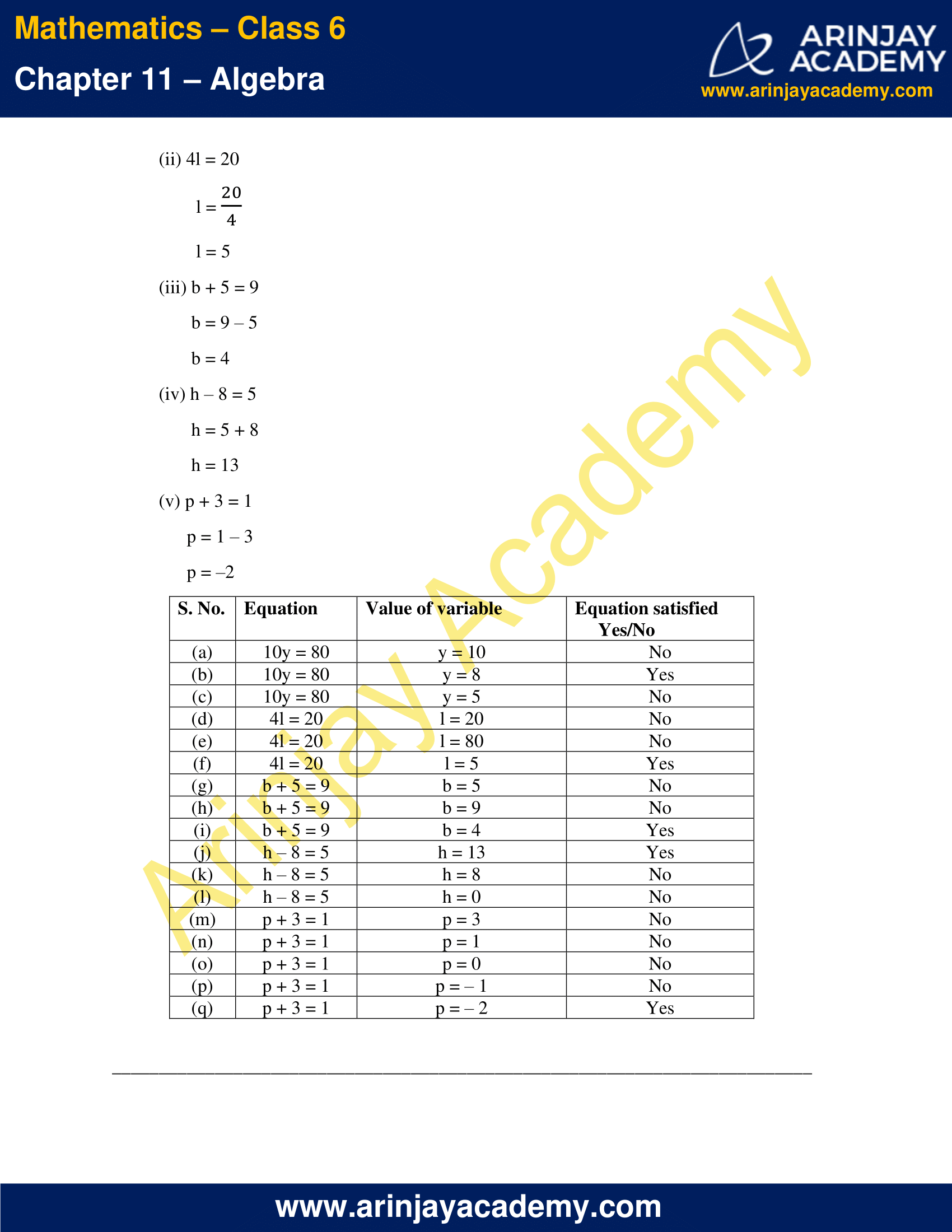

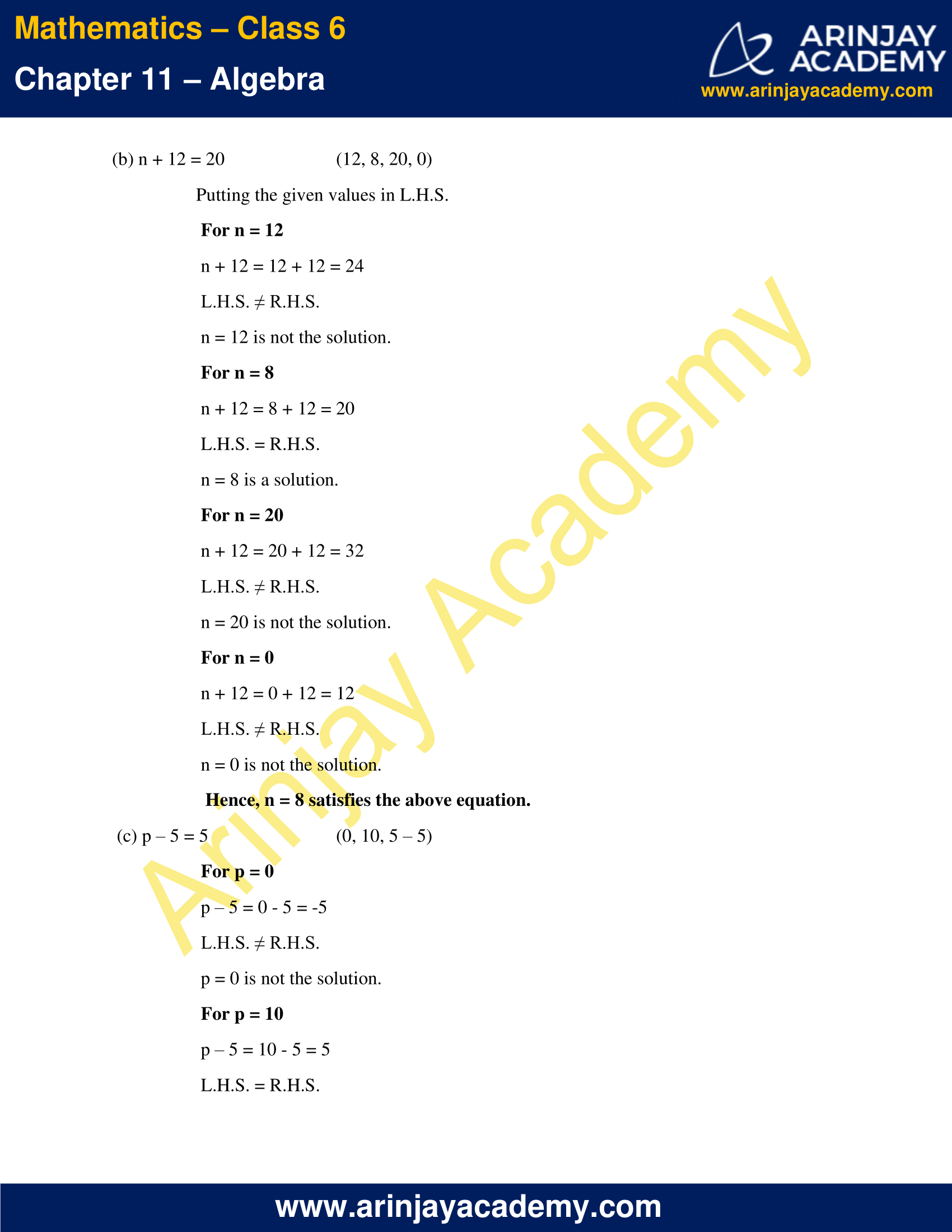
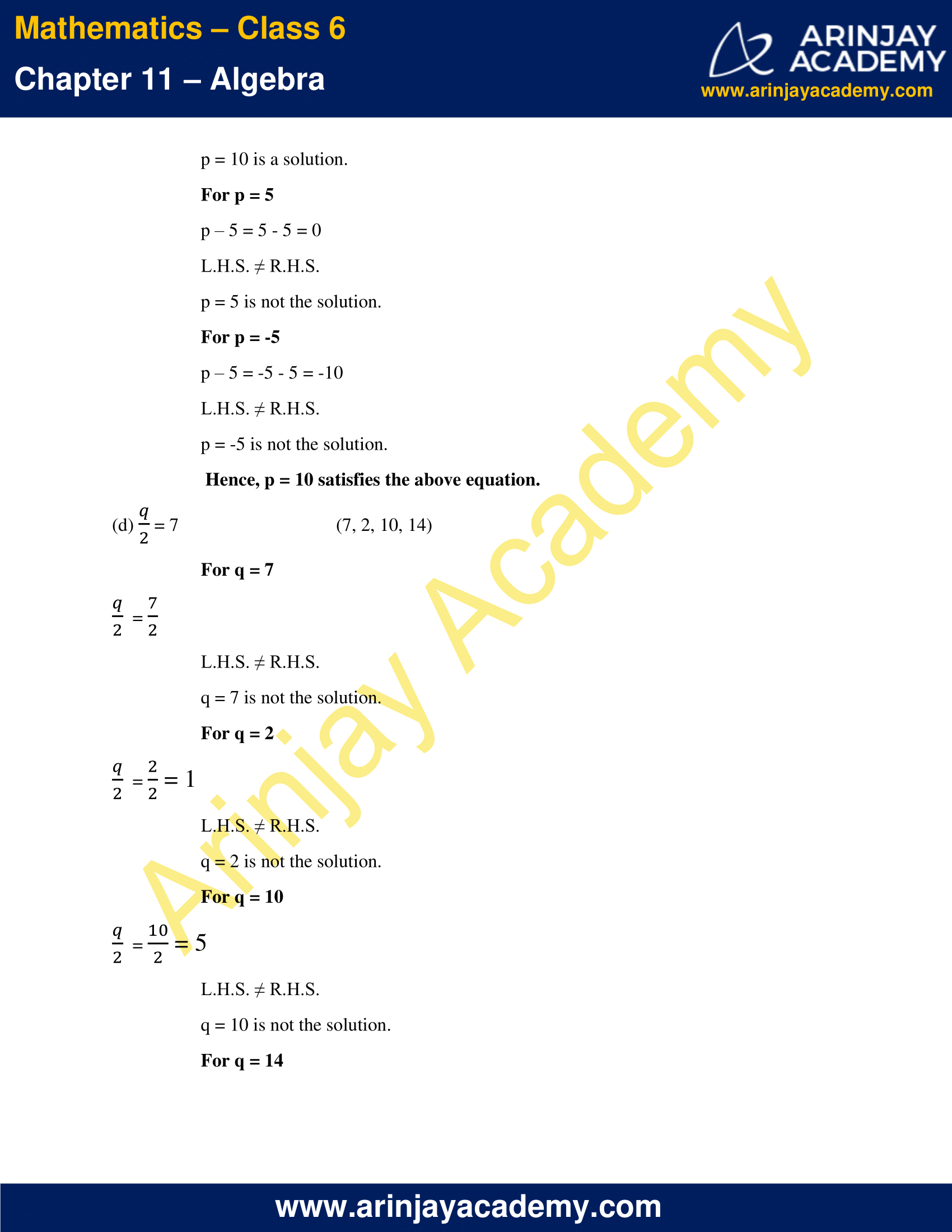
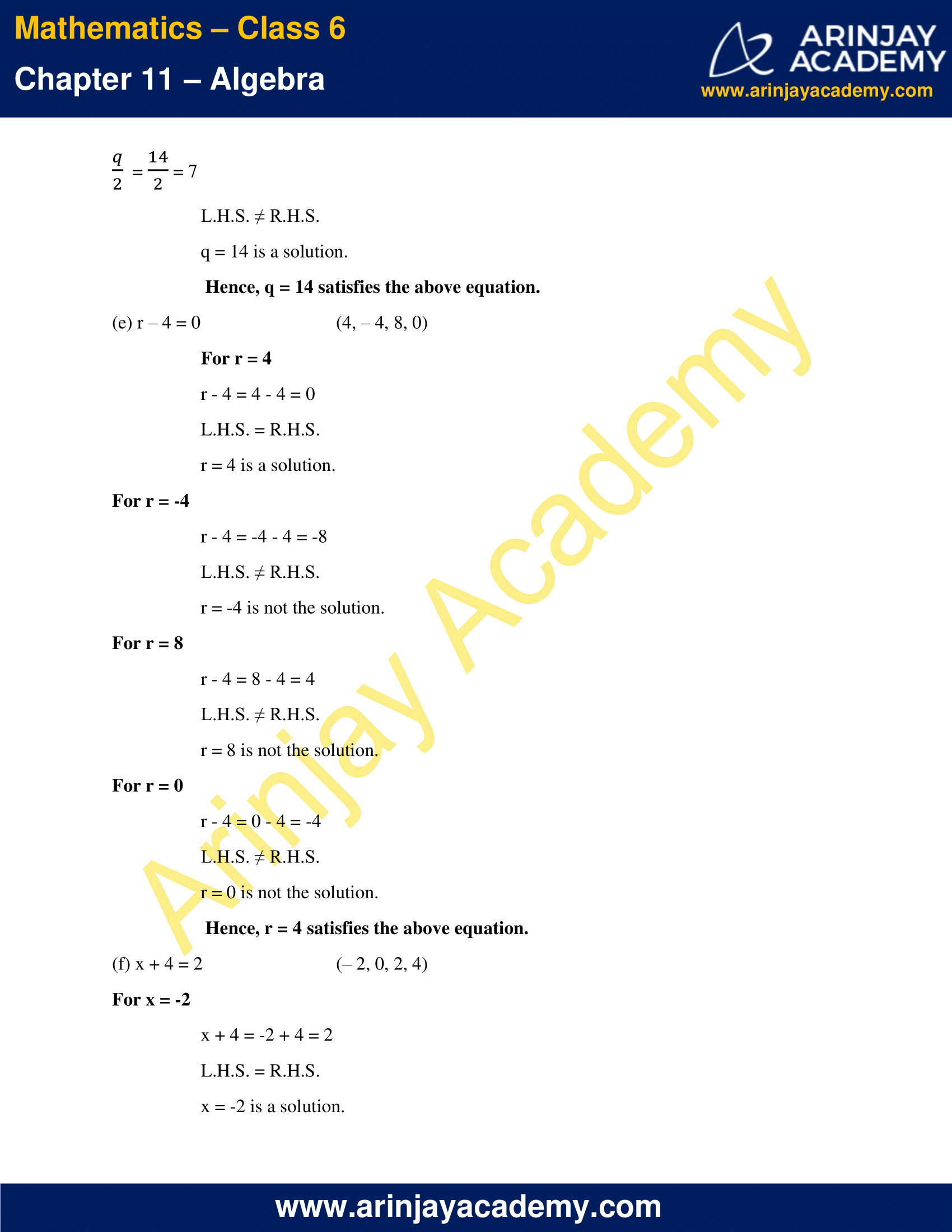

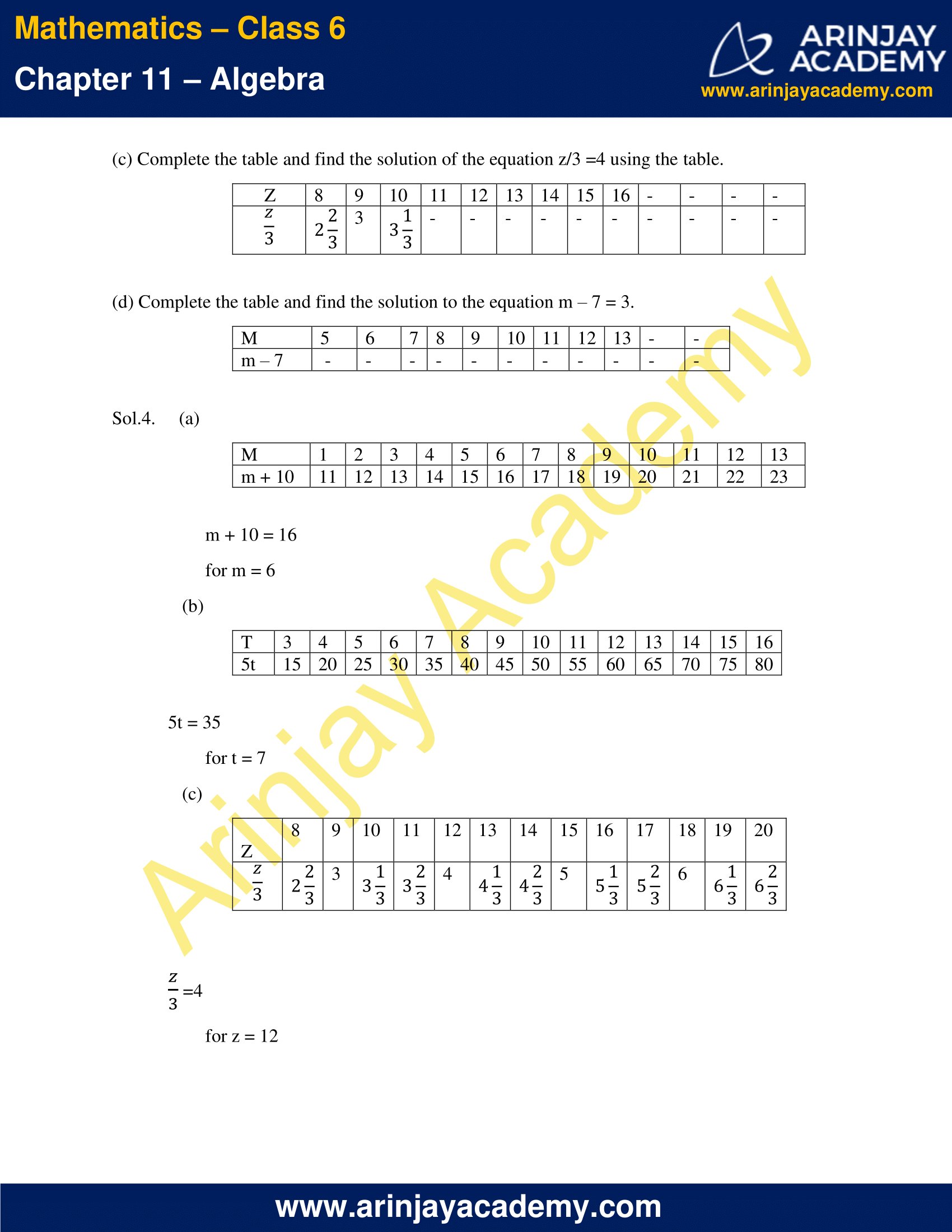

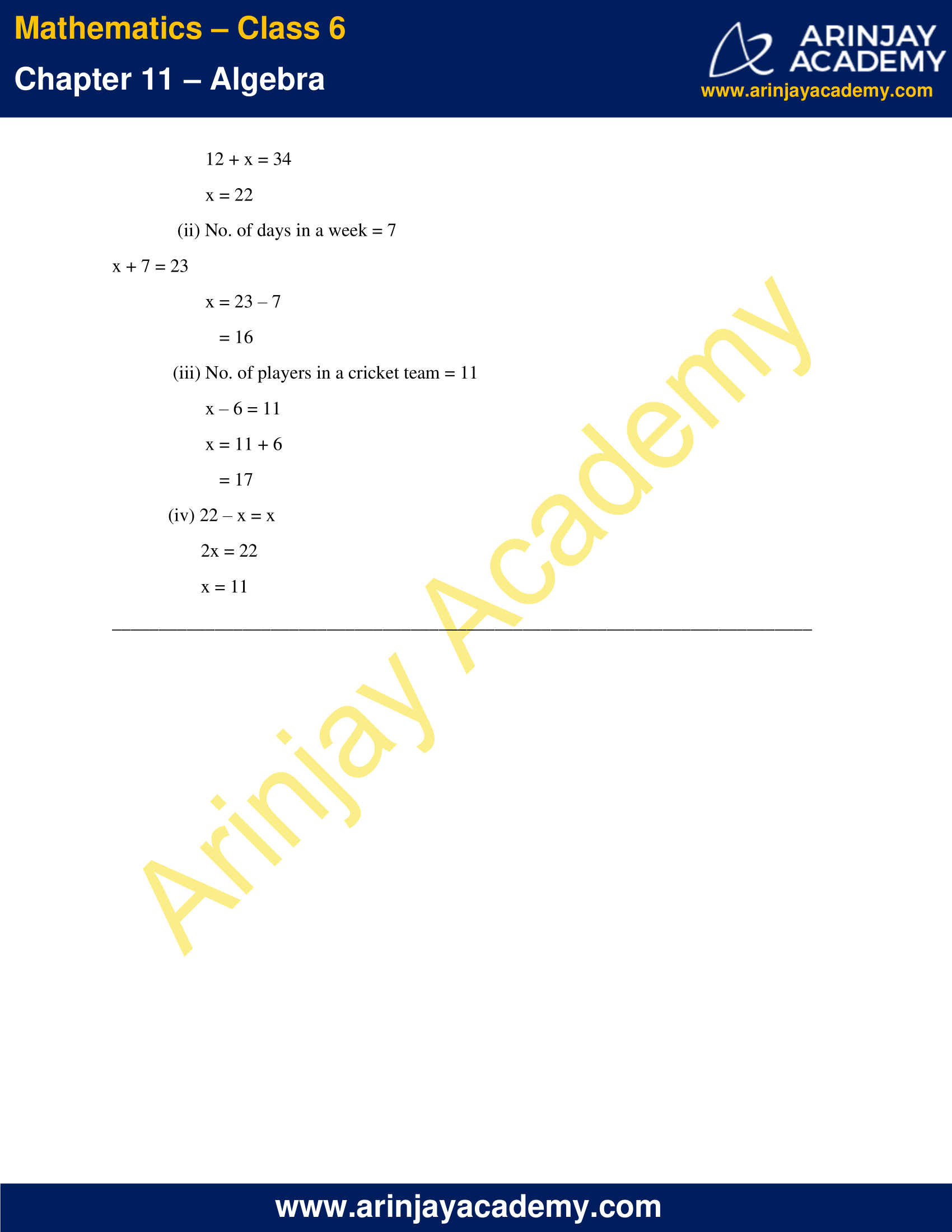
NCERT Solutions for Class 6 Maths Chapter 11 Exercise 11.1
Ques. 1. Find the rule which gives the number of matchsticks required to make the following matchstick patterns. Use a variable to write the rule.

Sol.1. (a) A pattern of letter T = 2n (as 2 matchsticks are used in one letter)
(b) A pattern of letter Z = 3n (as 3 matchsticks are used in one letter)
(c) A pattern of letter U = 3n (as 3 matchsticks are used in one letter)
(d) A pattern of letter V = 2n (as 2 matchsticks are used in one letter)
(e) A pattern of letter E = 5n (as 5 matchsticks are used in one letter)
(f) A pattern of letter S = 5n (as 5 matchsticks are used in one letter)
(g) A pattern of letter A = 6n (as 6 matchsticks are used in one letter)
Ques. 2. We already know the rule for the pattern of letters L, C and F. Some of the letters from Q.1 (given above) give us the same rule as that given by L. Which are these? Why does this happen?
Sol.2. The rule for the pattern of letter L = 2n (as 2 matchsticks are used in letter L)
From Q.1, (a) and (d), i.e., letters T and V, give the same rule as that given by L, i.e., 2n. This is because, 2 matchsticks are used in each of these letters.
Ques. 3. Cadets are marching in a parade. There are 5 cadets in a row. What is the rule which gives the number of cadets, given the number of rows? (Use n for the number of rows.)
Sol.3. No. of rows = n
No. of cadets in one row = 5
Hence, the no. of cadets in n rows = 5n
Ques. 4. If there are 50 mangoes in a box, how will you write the total number of mangoes in terms of the number of boxes? (Use b for the number of boxes.)
Sol.4. No. of boxes = b
No. of mangoes in a box = 50
Hence, total no. of mangoes in b boxes = 50b
Ques. 5. The teacher distributes 5 pencils per student. Can you tell how many pencils are needed, given the number of students? (Use ‘s’ for the number of students.)
Sol.5. No. of students = s
No. of pencils to be distributed per student = 5
Hence, total no. of pencils needed to be distributed among s students = 5s
Ques. 6. A bird flies 1 kilometer in one minute. Can you express the distance covered by the bird in terms of its flying time in minutes? (Use ‘t’ for flying time in minutes.)
Sol.6. Distance covered by the bird in 1 minute = 1 km
Flying time in minutes = t min
Distance covered by the bird in t minutes = speed x time = 1 x t = t km
Ques. 7. Radha is drawing a dot Rangoli (a beautiful pattern of lines joining dots with chalk powder. She has 8 dots in a row. How many dots will her Rangoli have for r rows?
How many dots are there if there are 8 rows? If there are 10 rows?
Sol.7. No. of dots in 1 row = 8
No. of rows = r
No. of dots in r rows = 8r
For no. of rows = 8,
No. of dots in 8 rows = 8 × 8 = 64 dots
For no. of rows = 10,
No. of dots in 10 rows = 8 × 10 = 80 dots
Ques. 8. Leela is Radha’s younger sister. Leela is 4 years younger than Radha. Can you write Leela’s age in terms of Radha’s age? Take Radha’s age to be x years.
Sol.8. Radha’s age = x years
Hence, Leela’s age = 4 years less than Radha’s age
= (x – 4) years
Ques. 9. Mother has made laddus. She gives some laddus to guests and family members; still 5 laddus remain. If the number of laddus mother gave away is l, how many laddus did she make?
Sol.9. No. of laddus given to guests and family members = l
No. of laddus remaining = 5
No. of laddus made by her = l + 5
Ques. 10. Oranges are to be transferred from larger boxes into smaller boxes. When a large box is emptied, the oranges from it fill two smaller boxes and still 10 oranges remain outside. If the number of oranges in a small box are taken to be x, what is the number of oranges in the larger box?
Sol.10. No. of oranges in 1 small box = x
No. of oranges in 2 small boxes = 2x
No. of oranges remaining outside = 10
Hence, the total no. of oranges in the large box = 2x + 10
Ques. 11. (a) Look at the following matchstick pattern of squares. The squares are not separate. Two neighbouring squares have a common matchstick. Observe the patterns and find the rule that gives the number of matchsticks in terms of the number of squares. (Hint: If you remove the vertical stick at the end, you will get a pattern of Cs.)

(b) Figure gives a matchstick pattern of triangles. As in Exercise 11 (a) above, find the general rule that gives the number of matchsticks in terms of the number of triangles.

Sol. 11
(a) In given figure, if we remove 1 vertical matchstick from each figure, we get the pattern of Cs.
No. of matchsticks in a C = 3
No. of matchsticks in a pattern of Cs = 3x
No. of matchsticks in a square = 3 + 1
For no. of squares = x
No. of matchsticks = 3x + 1
(b) In given figure, if we remove 1 matchstick from each figure, we get the pattern of 2 matchsticks, forming a table of 2.
No. of matchsticks in a pattern so formed = 2x
No. of matchsticks in a triangle = 2 + 1
For no. of triangles = x
No. of matchsticks = 2x + 1
NCERT Solutions for Class 6 Maths Chapter 11 Exercise 11.2
Ques. 1. The side of an equilateral triangle is shown by l. Express the perimeter of the equilateral triangle using l.
Sol.1. The side of an equilateral triangle = l
Perimeter = 3 × side of an equilateral triangle
= 3 × l
= 3l
Ques. 2. The side of a regular hexagon (given figure) is denoted by l. Express the perimeter of the hexagon using l. (Hint: A regular hexagon has all its six sides equal in length.)
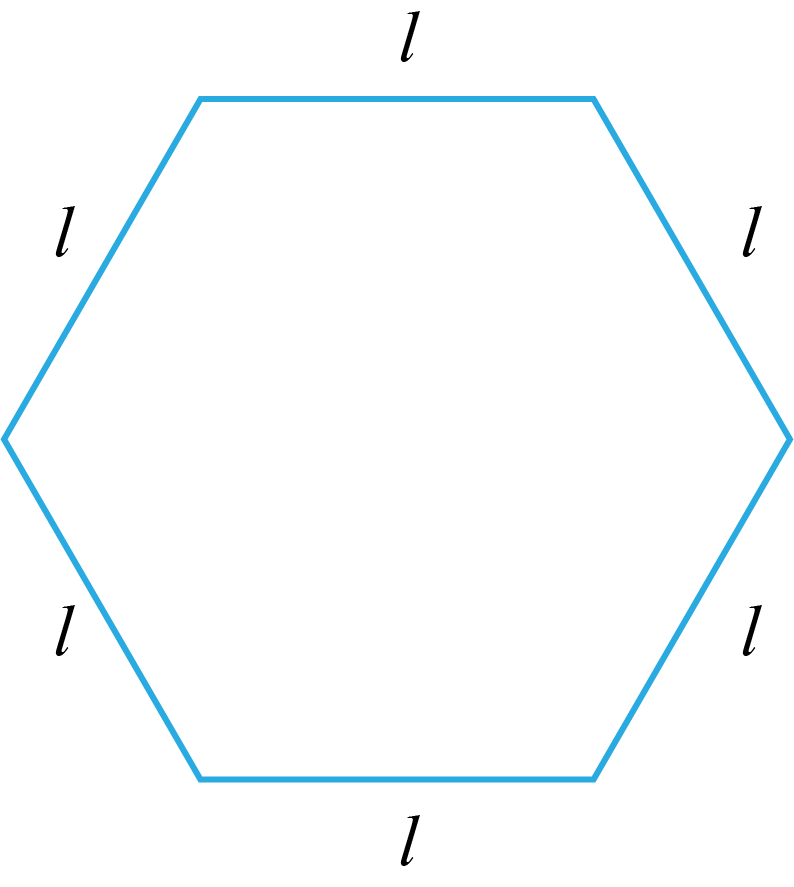
Sol.2. The side of a regular hexagon = l
Perimeter = 6 × side of a regular hexagon
= 6 × l
= 6l
Ques. 3. A cube is a three-dimensional figure as shown in given figure. It has six faces and all of them are identical squares. The length of an edge of the cube is given by l. Find the formula for the total length of the edges of a cube.

Sol.3. No. of edges of a cube = 12
Length of an edge of the cube = l
Total length of the edges of the cube = 12 × l
= 12l
Ques. 4. The diameter of a circle is a line which joins two points on the circle and also passes through the centre of the circle. (In the adjoining figure AB is a diameter of the circle; C is its centre.) Express the diameter of the circle (d) in terms of its radius (r).

Sol.4. Radius of the circle = r
Diameter of the circle = AB
d = CA + CB
d = r + r
d = 2r
Ques. 5. To find sum of three numbers 14, 27 and 13, we can have two ways:
(a) We may first add 14 and 27 to get 41 and then add 13 to it to get the total sum 54
(b) We may add 27 and 13 to get 40 and then add 14 to get the sum 54.
Thus, (14 + 27) + 13 = 14 + (27 + 13)
This can be done for any three numbers. This property is known as the associativity of addition of numbers. Express this property which we have already studied in the chapter on Whole Numbers, in a general way, by using variables a, b and c.
Sol.5. By using variable a, b and c, the property of associativity of addition of numbers can be expressed as,
(a + b) + c = a + (b + c)
NCERT Solutions for Class 6 Maths Chapter 11 Exercise 11.3
Ques. 1. Make up as many expressions with numbers (no variables) as you can from three numbers 5, 7 and 8. Every number should be used not more than once. Use only addition, subtraction and multiplication.
(Hint: Three possible expressions are 5 + (8 – 7), 5 – (8 – 7), (5 × 8) + 7; make the other expressions.)
Sol.1. (a) 5 x (8 – 7)
(b) 5 – (8 + 7)
(c) 5 × (7 + 8)
(d) 5 + (7 × 8)
(e) (8 × 7) – 5
(f) (8 + 7) – 5
(g) (8 × 5) – 7
(h) (7 × 5) + 8
Ques. 2. Which out of the following are expressions with numbers only?
(a) y + 3
(b) (7 × 20) – 8z
(c) 5 (21 – 7) + 7 × 2
(d) 5
(e) 3x
(f) 5 – 5n
(g) (7 × 20) – (5 × 10) – 45 + p
Sol.2. The following are expressions with numbers only:
(c) 5 (21 – 7) + 7 × 2
(d) 5
Ques. 3. Identify the operations (addition, subtraction, division, multiplication) in forming the following expressions and tell how the expressions have been formed.
(a) z +1, z – 1, y + 17, y – 17
(b) 17y, y/17 , 5 z
(c) 2y + 17, 2 y – 17
(d) 7 m, – 7 m + 3, – 7 m – 3
Sol.3. (a) z +1 ⇒ Addition ⇒ 1 is added to z.
z – 1 ⇒ Subtraction ⇒ 1 is subtracted from z.
y + 17 ⇒ Addition ⇒ 17 is added to y
y – 17 ⇒ Subtraction ⇒ 17 is subtracted from y
(b) 17y ⇒ Multiplication ⇒ y is multiplied with 17
y/17 ⇒ Division ⇒ y is divided by 17
5z ⇒ Multiplication ⇒ z is multiplied with 5
(c) 2y + 17 ⇒ Multiplication and Addition ⇒ y is multiplied with 2 and 17 is added to the result
2y – 17 ⇒ Multiplication and Subtraction ⇒ y is multiplied with 2 and 17 is subtracted from the result
(d) 7m ⇒ Multiplication à m is multiplied with 7
– 7m + 3 ⇒ Multiplication and Addition ⇒ m is multiplied with -7 and 3 is added to the result.
– 7m – 3 ⇒ Multiplication and Subtraction ⇒ m is multiplied with -7 and 3 is subtracted from the result.
Ques. 4. Give expressions for the following cases.
(a) 7 added to p
(b) 7 subtracted from p
(c) p multiplied by 7
(d) p divided by 7
(e) 7 subtracted from – m
(f) – p multiplied by 5
(g) – p divided by 5
(h) p multiplied by – 5
Sol.4. (a) 7 added to p = p + 7
(b) 7 subtracted from p = p – 7
(c) p multiplied by 7 = 7p
(d) p divided by 7 = p/7
(e) 7 subtracted from – m = – m – 7
(f) – p multiplied by 5 = – 5p
(g) – p divided by 5 = – p/5
(h) p multiplied by – 5 = – 5p
Ques. 5. Give expressions in the following cases.
(a) 11 added to 2m
(b) 11 subtracted from 2m
(c) 5 times y to which 3 is added
(d) 5 times y from which 3 is subtracted
(e) y is multiplied by – 8
(f) y is multiplied by – 8 and then 5 is added to the result
(g) y is multiplied by 5 and the result is subtracted from 16
(h) y is multiplied by – 5 and the result is added to 16.
Sol.5. (a) 11 added to 2m = 2m + 11
(b) 11 subtracted from 2m = 2m – 11
(c) 5 times y to which 3 is added = 5y + 3
(d) 5 times y from which 3 is subtracted = 5y – 3
(e) y is multiplied by – 8 = – 8y
(f) y is multiplied by – 8 and then 5 is added to the result = – 8y + 5
(g) y is multiplied by 5 and the result is subtracted from 16 = 16 – 5y
(h) y is multiplied by – 5 and the result is added to 16 = – 5y + 16
Ques. 6. (a) Form expressions using t and 4. Use not more than one number operation. Every expression must have t in it.
(b) Form expressions using y, 2 and 7. Every expression must have y in it. Use only two number operations. These should be different.
Sol.6. (a) t + 4, 4 + t, t – 4, 4 – t, 4t, t/4, 4/t
(b) 2y + 7, 7y + 2, 2y – 7, 7y – 2
NCERT Solutions for Class 6 Maths Chapter 11 Exercise 11.4
Ques. 1. Answer the following:
(a) Take Sarita’s present age to be y years
(i) What will be her age 5 years from now?
(ii) What was her age 3 years back?
(iii) Sarita’s grandfather is 6 times her age. What is the age of her grandfather?
(iv) Grandmother is 2 years younger than grandfather. What is grandmother’s age?
(v) Sarita’s father’s age is 5 years more than 3 times Sarita’s age. What is her father’s age?
(b) The length of a rectangular hall is 4 meters less than 3 times the breadth of the hall. What is the length, if the breadth is b meters?
(c) A rectangular box has height h cm. Its length is 5 times the height and breadth is 10 cm less than the length. Express the length and the breadth of the box in terms of the height.
(d) Meena, Beena and Leena are climbing the steps to the hill top. Meena is at step s, Beena is 8 steps ahead and Leena 7 steps behind. Where are Beena and Meena?
The total number of steps to the hill top is 10 less than 4 times what Meena has reached. Express the total number of steps using.
(e) A bus travels at v km per hour. It is going from Daspur to Beespur. After the bus has travelled 5 hours, Beespur is still 20 km away. What is the distance from Daspur to Beespur? Express it using v.
Sol.1.
(a)Sarita’s present age = y years
(i) Her age 5 years from now = y + 5
(ii) Her age 3 years back = y – 3
(iii) Sarita’s grandfather is 6 times her age.
The age of her grandfather = 6y
(iv) Grandmother is 2 years younger than grandfather.
Grandmother’s age = 6y – 2
(v) Sarita’s father’s age is 5 years more than 3 times Sarita’s age.
Her father’s age = 3y + 5
(b) Breadth of the rectangular hall = b meters
The length of a rectangular hall is 4 meters less than 3 times the breadth.
Hence, the length of the hall = (3b – 4) meters
(c) Height of the rectangular box = h cm
Its length is 5 times the height and the breadth is 10 cm less than the length.
Length of the rectangular box = 5h cm
Breadth of the rectangular box = (5h – 10) cm
(d) Meena is at step s.
Beena is 8 steps ahead and Leena 7 steps behind.
Hence, Beena is at step (s + 8).
Leena is at step (s – 7).
The total number of steps to the hill top is 10 less than 4 times what Meena has reached.
Hence, the total number of steps to the hill top = 4s – 10
(e) Speed of bus = v km per hour
After the bus has travelled 5 hours, Beespur is still 20 km away.
Distance covered in 5 hours = 5v km
Distance to be covered yet = 20 km
Total distance between Daspur and Beespur = (5v + 20) km
Ques. 2. Change the following statements using expressions into statements in ordinary language. (For example, Given Salim scores r runs in a cricket match, Nalin scores (r + 15) runs. In ordinary language – Nalin scores 15 runs more than Salim.)
(a) A notebook costs Rs p. A book costs Rs 3 p.
(b) Tony puts q marbles on the table. He has 8 q marbles in his box.
(c) Our class has n students. The school has 20 n students.
(d) Jaggu is z years old. His uncle is 4 z years old and his aunt is (4z – 3) years old.
(e) In an arrangement of dots there are r rows. Each row contains 5 dots.
Sol.2. (a) A book costs 3 times the cost of a notebook.
(b) Tony’s box contains 8 times the marbles on the table.
(c) The school has 20 times the students that our class has.
(d) Jaggu’s uncle in 4 times his age and his aunt is 3 years younger than his uncle.
(e) The total number of dots is 5 times the number of rows.
Ques. 3. (a) Given Munnu’s age to be x years, can you guess what (x – 2) may show? (Hint: Think of Munnu’s younger brother.) Can you guess what (x + 4) may show? What (3 x + 7) may show?
(b) Given Sara’s age today to be y years. Think of her age in the future or in the past. What will the following expression indicate? y + 7, y – 3, y + 4 1⁄2, y – 2 1⁄2.
(c) Given n students in the class like football, what may 2n show? What may n/2 show? (Hint: Think of games other than football).
Sol.3. (a) Munnu’s age = x years
(x – 2) shows 2 years younger than Munnu’s age.
(x + 4) shows 4 years elder than Munnu’s age.
(3x + 7) shows 7 years more than 3 times Munnu’s age.
(b) Sara’s age today = y years
(y + 7) indicates her age 7 years later.
(y – 3) indicates her age 3 years back.
(y + 4 1⁄2) indicates her age 4 years 6 months later.
(y – 2 1⁄2) indicates her age 2 years 6 months back.
(c) n students in the class like football.
2n shows twice the number of students in a class who like cricket.
n/2 shows half the number of students in a class who like basketball.
NCERT Solutions for Class 6 Maths Chapter 11 Exercise 11.5
Ques. 1. State which of the following are equations (with a variable). Give reason for your answer. Identify the variable from the equations with a variable.
(a) 17 = x + 7
(b) (t – 7) > 5
(c) 4/2 = 2
(d) (7 × 3) – 19 = 8
(e) 5 × 4 – 8 = 2 x
(f) x – 2 = 0
(g) 2m < 30
(h) 2n + 1 = 11
(i) 7 = (11 × 5) – (12 × 4)
(j) 7 = (11 × 2) + p
(k) 20 = 5y
(l) 3q/2 < 5
(m) z + 12 > 24
(n) 20 – (10 – 5) = 3 × 5
(o) 7 – x = 5
Sol.1. (a) It is an equation with variable x. It is an equation because it has equality sign between the expressions 17 and x + 17.
(b) It is not an equation as L.H.S. is greater than R.H.S.
(c) It is an equation with no variable.
(d) It is an equation with no variable.
(e) It is an equation with variable x. It is an equation because it has equality sign between the expressions 5 × 4 – 8 and 2x.
(f) It is an equation with variable x. It is an equation because it has equality sign between the expressions x – 2 and 0.
(g) It is not an equation as L.H.S. is less than R.H.S.
(h) It is an equation with variable n. It is an equation because it has equality sign between the expressions 2n + 1 and 11.
(i) It is an equation with no variable.
(j) It is an equation with variable p. It is an equation because it has equality sign between the expressions 7 and (11 × 2) + p.
(k) It is an equation with variable y. It is an equation because it has equality sign between the expressions 20 and 5y.
(l) It is not an equation as L.H.S. is less than R.H.S.
(m) It is not an equation as L.H.S. is greater than R.H.S.
(n) It is an equation with no variable.
(o) It is an equation with variable x. It is an equation because it has equality sign between the expressions 7 – x and 5.
Ques. 2. Complete the entries in the third column of the table.

Sol.2. On solving, we find that,
(i) 10y = 80
y = 80/10
y = 8
(ii) 4l = 20
l = 20/4
l = 5
(iii) b + 5 = 9
b = 9 – 5
b = 4
(iv) h – 8 = 5
h = 5 + 8
h = 13
(v) p + 3 = 1
p = 1 – 3
p = –2
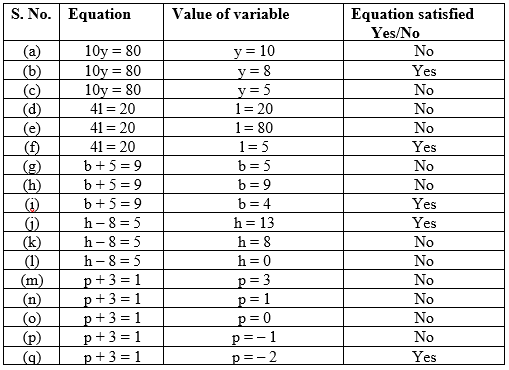
Ques. 3. Pick out the solution from the values given in the bracket next to each equation. Show that the other values do not satisfy the equation.
(a) 5m = 60 (10, 5, 12, 15)
(b) n + 12 = 20 (12, 8, 20, 0)
(c) p – 5 = 5 (0, 10, 5 – 5)
(d) q/2 = 7 (7, 2, 10, 14)
(e) r – 4 = 0 (4, – 4, 8, 0)
(f) x + 4 = 2 (– 2, 0, 2, 4)
Sol.3. (a) 5m = 60 (10, 5, 12, 15)
Putting the given values in L.H.S.
For m = 10
5m = 5 x 10 = 50
L.H.S. ≠ R.H.S.
m = 10 is not the solution.
For m = 5
5m = 5 x 5 = 25
L.H.S. ≠ R.H.S.
m = 5 is not the solution.
For m = 12
5m = 5 x 12 = 60
L.H.S. = R.H.S.
m = 12 is a solution.
For m = 15
5m = 5 x 15 = 75
L.H.S. ≠ R.H.S.
m = 15 is not the solution.
Hence, m = 12 satisfies the above equation.
(b) n + 12 = 20 (12, 8, 20, 0)
Putting the given values in L.H.S.
For n = 12
n + 12 = 12 + 12 = 24
L.H.S. ≠ R.H.S.
n = 12 is not the solution.
For n = 8
n + 12 = 8 + 12 = 20
L.H.S. = R.H.S.
n = 8 is a solution.
For n = 20
n + 12 = 20 + 12 = 32
L.H.S. ≠ R.H.S.
n = 20 is not the solution.
For n = 0
n + 12 = 0 + 12 = 12
L.H.S. ≠ R.H.S.
n = 0 is not the solution.
Hence, n = 8 satisfies the above equation.
(c) p – 5 = 5 (0, 10, 5 – 5)
For p = 0
p – 5 = 0 – 5 = -5
L.H.S. ≠ R.H.S.
p = 0 is not the solution.
For p = 10
p – 5 = 10 – 5 = 5
L.H.S. = R.H.S.
p = 10 is a solution.
For p = 5
p – 5 = 5 – 5 = 0
L.H.S. ≠ R.H.S.
p = 5 is not the solution.
For p = -5
p – 5 = -5 – 5 = -10
L.H.S. ≠ R.H.S.
p = -5 is not the solution.
Hence, p = 10 satisfies the above equation.
(d) q/2 = 7 (7, 2, 10, 14)
For q = 7
q/2 = 7/2
L.H.S. ≠ R.H.S.
q = 7 is not the solution.
For q = 2
q/2 = 2/2 = 1
L.H.S. ≠ R.H.S.
q = 2 is not the solution.
For q = 10
q/2 = 10/2 = 5
L.H.S. ≠ R.H.S.
q = 10 is not the solution.
For q = 14
q/2 = 14/2 = 7
L.H.S. ≠ R.H.S.
q = 14 is a solution.
Hence, q = 14 satisfies the above equation.
(e) r – 4 = 0 (4, – 4, 8, 0)
For r = 4
r – 4 = 4 – 4 = 0
L.H.S. = R.H.S.
r = 4 is a solution.
For r = -4
r – 4 = -4 – 4 = -8
L.H.S. ≠ R.H.S.
r = -4 is not the solution.
For r = 8
r – 4 = 8 – 4 = 4
L.H.S. ≠ R.H.S.
r = 8 is not the solution.
For r = 0
r – 4 = 0 – 4 = -4
L.H.S. ≠ R.H.S.
r = 0 is not the solution.
Hence, r = 4 satisfies the above equation.
(f) x + 4 = 2 (– 2, 0, 2, 4)
For x = -2
x + 4 = -2 + 4 = 2
L.H.S. = R.H.S.
x = -2 is a solution.
For x = 0
x + 4 = 0 + 4 = 4
L.H.S. ≠ R.H.S.
x = 0 is not the solution.
For x = 2
x + 4 = 2 + 4 = 6
L.H.S. ≠ R.H.S.
x = 2 is not the solution.
For x = 4
x + 4 = 4 + 4 = 8
L.H.S. ≠ R.H.S.
x = 4 is not the solution.
Hence, x = -2 satisfies the above equation.
Ques. 4. (a) Complete the table and by inspection of the table find the solution to the equation m + 10 = 16.

(b) Complete the table and by inspection of the table, find the solution to the equation 5t = 35.

(c) Complete the table and find the solution of the equation z/3 =4 using the table.

(d) Complete the table and find the solution to the equation m – 7 = 3.
![]()
Sol.4. (a)
![]()
m + 10 = 16
for m = 6
(b)
![]()
5t = 35
for t = 7
(c)

z/3 = 4
for z = 12
(d)

m – 7 = 3
for m = 10
Ques. 5. Solve the following riddles, you may yourself construct such riddles.
Who am I?
(i) Go round a square
Counting every corner
Thrice and no more!
Add the count to me
To get exactly thirty four!
(ii) For each day of the week
Make an upcount from me
If you make no mistake
You will get twenty three!
(iii) I am a special number
Take away from me a six!
A whole cricket team
You will still be able to fix!
(iv) Tell me who I am
I shall give a pretty clue!
You will get me back
If you take me out of twenty two!
Sol.5. (i) No. of corners of a square = 4
4×3 + x = 34
12 + x = 34
x = 22
(ii) No. of days in a week = 7
x + 7 = 23
x = 23 – 7
= 16
(iii) No. of players in a cricket team = 11
x – 6 = 11
x = 11 + 6
= 17
(iv) 22 – x = x
2x = 22
x = 11
With this we come to the end of NCERT Solutions for Class 6 Maths Chapter 11 Algebra. We hope these helped you study your subject.